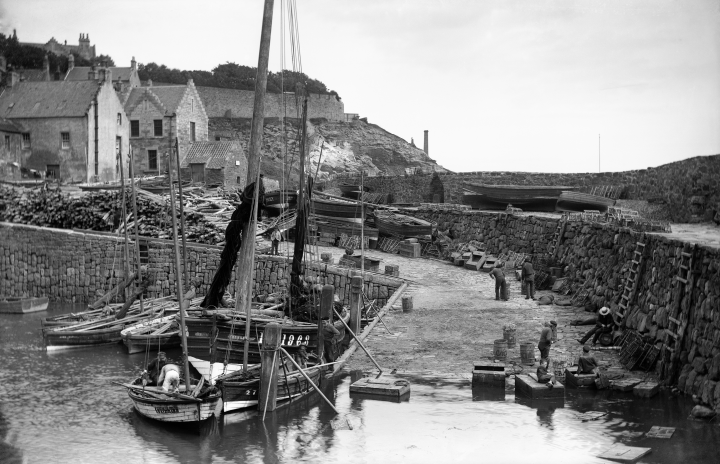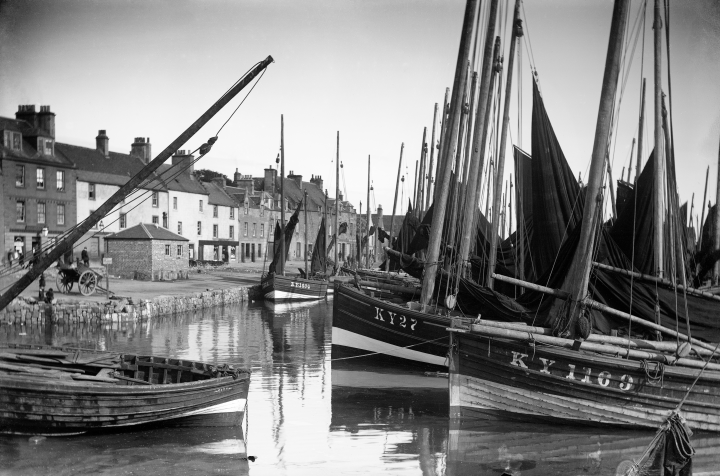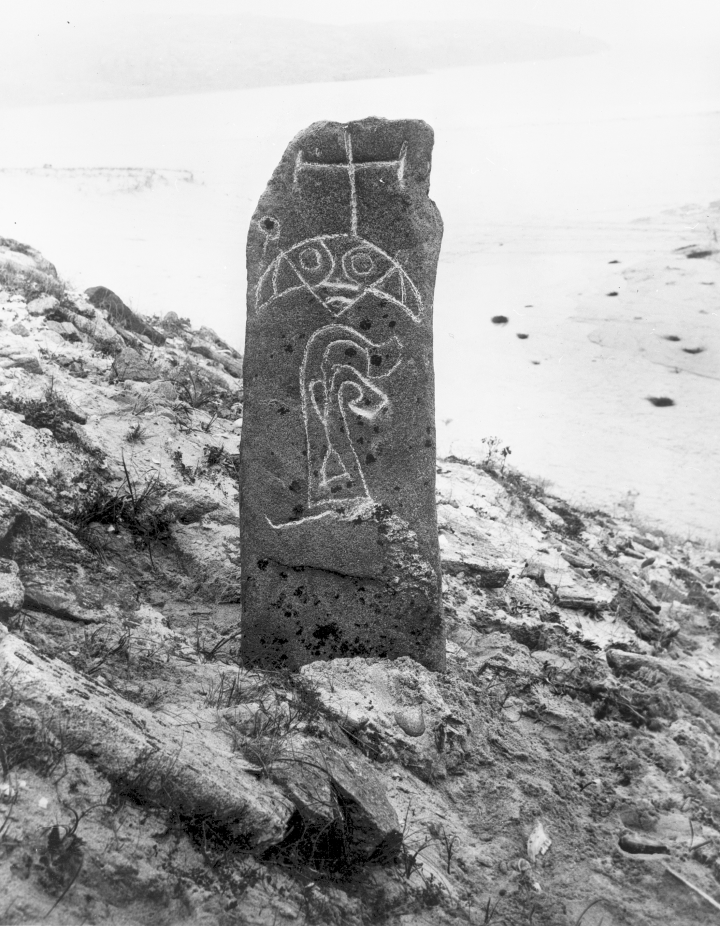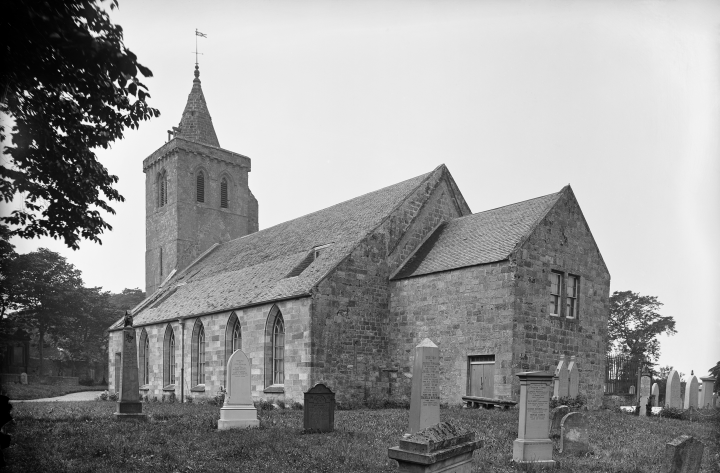Scottish Art News
Latest news
Magazine
News & Press
Publications
Erskine Beveridge: Collecting Relics, Ruins & Ways of Life
By Neil Cooper, 15.10.2021

Man With a Camera
When Erskine Beveridge picked up a camera in the late 1800s, this revolutionary way of immortalising the world was perfect for documenting the Dunfermline born mill owner’s archaeological adventures across Scotland. While Beveridge’s images would go on to appear in his assorted publications, it was only when a pile of neglected glass plate photographic negatives was accidentally discovered that a vital archive of the country’s landscape on the brink of seismic social change was preserved.
The discovery occurred while surveyors from the Royal Commission on the Ancient and Historical Monuments of Scotland (which later joined forces with Historic Scotland to form Historical Environment Scotland) were looking over one of Beveridge’s soon to be demolished mills in the early 1960s. A later donation of another box of glass plate negatives rescued from a skip and stored in a wardrobe for many years expanded the collection further. Several other boxes believed to have held even more negatives are now lost.
Combined, the salvaged collections reveal between 800 and 900 photographs taken by Beveridge between 1880 and 1919, prior to his death in 1920. The images shed light, not just on the subjects captured by his lens, but also on Beveridge himself. As a restlessly curious auteur, he documented his passion with an artistry that went beyond his acquired status as one of the finest amateur photographers of his generation.
Some of Beveridge’s oeuvre as historian, archaeologist and photographer can be gleaned in 'Erskine Beveridge: Collecting Relics, Ruins & Ways of Life', a new exhibition currently running at Taigh Chearsabhagh Museum & Arts Centre, in Lochmaddy, North Uist, in the Western Isles. The host venue is close to Vallay, the now unoccupied tidal island where Beveridge built a house while he continued his archaeological excavations.
Presented by Historic Environment Scotland, the Taigh Chearsabhagh exhibition features a selection of nineteen photographs by Beveridge seen alongside ten more images from other HES projects. As curated by Carolyn Alexander, the result is a monument of sorts to both Beveridge and his concerns.
As its title suggests, there are three strands to the exhibition. The first includes a study of fragments of the then yet to be reconstructed St John’s Cross on Iona. The second features a picture of the ruins of Dryburgh Abbey in the Scottish Borders. A photograph of the harbour in Crail, Fife, stands out in the third section. Seen together, the nineteen photographs and supplementary material puts Beveridge’s photographic output in the context of other archaeologists of his era.
Beyond the images themselves, other stories start to peek through the frame that reveal as much about the man as his art. Some photographs in the current exhibition also reveal hints of Beveridge’s maverick ways of ensuring he got a good picture. This is most evident in his image of the pieces of St. John’s Cross, which he had noticeably moved around in order to show them off in their best light. Similarly, a symbol stone on Pabbay had clearly been tampered with before Beveridge took his picture.
While such a cavalier approach would be regarded as sacrilege to contemporary archaeologists, it nevertheless points to Beveridge’s more playful nature that drove him as he stomped around the country. This became increasingly evident to HES’ Head of Archives Lesley Ferguson the more she looked into Beveridge’s work.
“I have always been very familiar with the photographs which were in the collection I looked after,” says Ferguson, “and back in the dim and distant early 2000s, I pulled all the photographs together and started looking at it as a collection. I then started looking at Erskine himself, and one thing led to another, and I ended up pulling the images together, travelling the country trying to visit places he'd visited, and trying to recreate the views, doing a then and now, which is always a fascinating journey.
“But I got really interested in Beveridge himself, because it seemed to me that when I looked at all those photographs, he was a quality photographer. Yes, he was an amateur, because he was a wealthy linen manufacturer, but the quality of his photographs was astonishing. For someone who was photographing in the 1870s, 1880s, 1890s, early 1900s, the quality was amazing.”
Ferguson’s research in the Carnegie Library in Dunfermline and elsewhere led to her writing a book on Beveridge. Wanderings With a Camera in Scotland: The Photography of Erskine Beveridge was originally published in 2009, drawing its title from a collection of Beveridge’s photographs published posthumously in 1922. Ferguson’s own book showcased more than 170 of Beveridge’s images. This ran alongside an exhibition, which opened at Taigh Chearsabhagh the same year, before touring to venues in places in Fife and the Highlands significant to Beveridge. The discovery of Beveridge’s negatives at the mill was crucial to this.
“They were destined for the bin,” says Ferguson. “They weren't being looked after, and no one really knew what they were, and they could have easily been lost.”
A similar fate could easily have befallen the box of negatives rescued from a skip.
“It makes you wonder what else could have been in that skip,” Ferguson says, “because we know there are other photographs. We've seen prints, but there are no negatives. We have a lovely story of a wealthy industrialist who was clearly very interested in the past and in photography, and he travelled the length and breadth of the country, photographing old buildings, street scenes, and archaeological sites. What we see is a partial record of what he has done.
“Researching Beveridge, and travelling around the country, following in his footsteps, so to speak, it became a bit of an obsession for a few years, and the book followed.
It was just one of those fascinating bits of research. With the photographs, you get a certain amount of his story, but in the Carnegie Library, we discovered some of his journals, and some of those journals will actually say ‘photograph this’, and we've got the photograph.
“So you get a little bit more of the background to Beveridge, because this photographic collection is very one sided. You get a part of the story, and you build a picture up based on those photographs. Then when you see some of his journals you discover there's far more to him, and I think there's much more to uncover.”
 © Courtesy of HES (Erskine Beveridge Collection).
© Courtesy of HES (Erskine Beveridge Collection).
Excavating Erskine
Erskine Beveridge was born in Dunfermline in 1851, the eldest of four children to a linen manufacturer father, also called Erskine, and his second wife, Maria. His father died when he was twelve, and the family firm was put into the hands of trustees before being run jointly by Beveridge, a brother, and a half brother. By the time he was in his late thirties, Beveridge had full control of the business, which became a world leader in fine linen.
The success of Erskine Beveridge and Co also allowed its head the freedom to explore his passions. While studying at the University of Edinburgh, Beveridge joined the Edinburgh Photographic Society. He channelled his interest into his antiquarian researches, illustrating his various publications with his photographs. His first book, The Churchyard Memorials of Crail, was published in 1893. This was followed by A Bibliography of Dunfermline and the West of Fife (1901), and The Burgh Records of Dunfermline, 1485-1584 (1917).
In between these came two archaeological studies; Coll and Tiree: Their Prehistoric Forts and Ecclesiastical Antiquities (1903); and North Uist: Its Archaeology and Topography (1911). Beveridge eventually settled in Vallay, where he lived with his family in the mansion-like house he built inbetween excavating numerous sites on the island.
Books by Beveridge published posthumously included The ‘Abers’ and ‘Invers’ of Scotland (1923), a study of Scottish place-names; and Fergusson’s Scottish Proverbs (1924), an annotated edition of a compilation published by David Fergusson in 1641. It was Wanderings with a Camera, 1882-1898 (1922), however, that revealed the breadth of Beveridge’s photographic excursions. As Ferguson also discovered, there was a lot more going on beyond Beveridge’s formal biography.
“I was interested in this concept of how much of someone's life can you put together from a photographic collection,” she says. “Because I think if you looked at my family photographs, you would get a very different view of life, just from the photographs.
“But Erskine Beveridge was quite a collector. When you read about his travels in Coll and Tiree for example, he walked the length and breadth of the islands, and in the diary he kept, you see that he spoke to the local doctor, and asked, what do you know about the archaeology, and can you direct me to different places I should look at?
“He spoke to all sorts of different people, and the diary gives an account of the bed and breakfast hotel he stayed in, and who he spoke to. It talks about him buying stone objects or bone pins from the children. On one of his journeys, his pockets are so full of objects he's dug out of the sand dunes, that he leaves a little mound at the side of the road to pick up later on, and then walks back.
“Now, whether he ever picked up that little mound of bits and bobs, I don't know. But as my background is in archaeology, the idea that a little pile that he might have left at the side of the road is causing intense confusion for the archaeologists today, I just find quite funny.”
Beveridge’s less than reverent adherence to archaeologists’ codes of not interfering with their finds appears to have been a common occurrence, as Ferguson discovered.
“There are two particular stories from his yachting holiday journal,” she says. “He was going around different islands, and it's quite clear from the journal he's looking for a carved stone of some kind on the island of Pabbay.
“We've got photographs of the stone on Pabbay, sitting upright, with the detail outlined with what looks like chalk. But when you read his diary, he talks about finding the stone lying flat. He puts it upright, clearly to get a good photograph, and what we took to be chalk is actually human bone, because he clearly found a bone eroding out of the local cemetery, and he used the bone to mark round the carvings, and it worked just like chalk.
“So you've got the photograph, and what you've taken to be the photograph of the stone in its original place, and that's how you've interpreted it. You then get his diary account, where he's actually saying it's lying flat, and he's marked round stones.”
The second story from Beveridge’s yachting diary sees him indulge in an even more blatant rearrangement of historical remains on the sacred isle of Iona.
“We've got these couple of lovely photograph showing fragments of St John’s Cross, one of the magnificent monuments on Iona, which were kept within a fenced enclosure. You've got one side in one photograph, and in another he’d clearly turned all the fragments over to photograph the carvings on the other side, to get a better picture.
“In the late nineteenth century on Iona, there were a lot of tourists, and there was a lot of damage being done to various monuments. So, a lot of the areas of interest were fenced off to prevent damage by tourists. It was quite normal to arrive on Iona and to have a tour. Someone would take you round. Well, from the diary, it's quite clear that Erskine Beveridge arrived, and the guide wasn't available, so a wee boy showed them round. And I think from what he said, they gave the wee boy money to go away. So he photographed the stones, then he climbed into the compound and turned them all over, so he could photograph the other sides.
“You wouldn't be allowed to do that if the guide had been there, but you've got the photographs, and you can think about how he managed to get both sides, and in his diary he’s given the account. There are little gems like that, that come through, and just put a little bit of flesh and human reality onto the photographs.”
Beveridge was fascinated by people, whether living or dead, and this fed into all his work.
“I think he was of his time,” Ferguson says of her subject. “In the late nineteenth century, there was this fascination with the past. There had been a lot of people doing research and creating lists of all the forts in the country, and all the carved stones in the country, and Beveridge was part of that.”
To illustrate this, Ferguson points to Beveridge’s first volume on the history of Crail.
“He photographed many of the gravestones,” Ferguson says, “but instead of just leaving it at that, he researched the people whose stones he was photographing, who were the people who had lived in Crail.
“In today's language it would be described as the privileged few, because they were the burgesses, the merchants, and so on, but in the nineteenth century, those are the people whose gravestones exist. They’re extensive, very expensive, and really quite flamboyant, some of them.”
In the land of the living, Beveridge made connections with various fellow travellers during his various sojourns. These included Sir Francis Tress Barry, the copper mine magnate who owned Keiss Castle in Caithness, where he excavated Nybster Broch. Beveridge also came into contact with Caithness born artist John Nicolson. Both attended Barry’s excavation, and Beveridge photographed Nicolson.
“There are connections right across Scottish culture,” Ferguson points out. “He's part of that idea of ‘let’s find out about the past, and let's record it’. Beveridge was a fellow, and the vice president of the Society of Antiquities of Scotland, so he was very much in that cultural mix of documenting the history he explored.”
 © Courtesy of HES (Erskine Beveridge Collection).
© Courtesy of HES (Erskine Beveridge Collection).
Casting the Ruins
While Beveridge’s photographs were taken during a time of flux, not all of the landscapes have disappeared, as Ferguson explains.
“If you go to Crail,” she says, “many of the buildings he was photographing are still there. Instead of horse manure on the street and chickens walking down the street, you've got parked cars and you've got lampposts. But the houses are still there, they are lived in, occupied, and contribute to the wonderful character of the East Neuk.”
One of Ferguson’s favourite photographs by Beveridge is of Ainster, in Anstruther.
“It’s a wonderful photograph of the harbour,” she says. “The quality of this image, you can see every twist in the rope in the fishing boats, you can see the pebbles on the seabed. And up on the hill, there is a church, and that church, when you enlarge the photograph, you can see the church is being built. You can see the scaffolding through the windows of the church. The glass isn’t in. You can see the scaffolding round the outside of the church. It is under construction. If you go there today, it's been demolished. It's an old folks home, flats or something like that. So, some places have changed a bit, other places have changed a lot.”
Another example of the latter was in Kinloch Rannoch, in Perthshire, where Ferguson struggled to find the original spot where Beveridge took his photograph.
“That was because the landscape had changed so much from what was a lovely photograph,” she says, “with water on the right of it, nice buildings, and Schiehallion in the background, and we struggled to find this.
“We then realised that what was a mill pond had at some point been turned into a rose garden. The trees had grown up, so you couldn't quite get the same view. We located it, but we were a bit surprised at how it had changed. It was the same across in some of the Argyll sites, where there were far fewer trees when Beveridge was there in the nineteenth century. There are far more trees now, so views that he captured are now obscured.
“But the foundations of many of the buildings are all still there. If you visit some of the communities he photographed in the Western Isles, in North Uist, and even in some of the buildings in Argyll, you can still make out the foundations. They were all occupied back then, and in many instances, he's actually photographed the occupant. So, the landscape has changed, but perhaps not as much as you’d think. But again, Beveridge was always out to get the best possible photograph.”
Ferguson illustrates this again with her own detective work.
“One of the sites I went to visit in Tiree was an early mediaeval site,” she says, “an early Christian site, andI was completely bamboozled, because that was the first time I realised he was picking up the carrstones and moving them, so that the sun would be on the face of the stone so he could get the best photograph.
“From an archaeological point of view that's a definite no-no, but that's the naughtiness of Beveridge coming through. He wanted the best photograph, and that comes down to the quality of image he was trying to get.
 © Courtesy of HES (Erskine Beveridge Collection).
© Courtesy of HES (Erskine Beveridge Collection).
Into Vallay
The current exhibition at Taigh Chearsabhagh was originally planned for 2020, to mark the centenary of Beveridge’s death. Like everything else, the commemoration was postponed due to pandemic induced lockdown. As restrictions ease, the new exhibition will hopefully tour other venues in the spirit of its 2009 predecessor. Dates for a run at Gairloch Heritage Museum in 2022 are already confirmed. Opening in North Uist, however, is a significant marker for Beveridge’s story.
Ferguson can’t be sure, but she suspects his move to Vallay was an extension of his earlier visits to Coll and Tiree, attracted by the high number of brochs and duns on North Uist. At a more human level, Ferguson suspects it was the natural beauty of the landscape that caused Beveridge to call it home.
“Coming from a linen manufacturing background, where I imagine the mills are noisy, the tranquillity and beauty of somewhere like North Uist might really have appealed to him,” Ferguson speculates. “To invest the amount of money he did in building that house, and to run a water pipe across and underneath the tidal sands as he did was a vast expanse. Some of the locals told me that running that water pipe cost more than the entire building of his house. So, I think, to settle there, particularly on a tidal island, he must have really fallen in love with the place.”
In an ironic twist, as with many of his photographic subjects, Beveridge’s house is still standing, but, as Ferguson puts it, is in “a really sad, ruinous state. It was recently listed by Historic Environment Scotland, but in the few years I was doing research, you could see the deterioration, and locals told me how you used to be able to see the wallpaper, and you used to be able to see this or that, but no longer.”
While Beveridge’s house remains a ruin to be photographed like his own images, its foundations in its former owner’s life are gradually being unearthed.
“A few years ago, a little bit like the glass negatives being found in the skip, someone approached us and gave us a floor plan of the house,” says Ferguson. “The locals had said Beveridge used to have his own darkroom in the house, but we couldn't tell, because you couldn't wander inside. But the floor plan clearly shows his darkroom. Again, that was local community information adding to what was known.”
Beveridge married twice. After his first wife died, he married a second time, to a much younger woman. To Ferguson’s delight, she discovered that Beveridge had two grandsons who were still alive.
“I met one of them in Crail,” she says, “and we stood outside the house where Erskine Beveridge had stayed on his holidays. The grandson was a keen yachtsman, and had visited Coll and Tiree and North Uist, and had been to one or two of the places his grandfather had been. That was lovely to find out.”
 © Courtesy of HES (Erskine Beveridge Collection).
© Courtesy of HES (Erskine Beveridge Collection).
Further Excavations
As Ferguson makes clear, there is plenty more of the Erskine Beveridge story to explore. She has yet to delve into his diaries from his trip to America and piece these together with the associated photographs that go with them. Ferguson points as well to the MacKinnon Collection, an archive of more than 14,000 images of Scottish life from the 1840s to the 1940s, put together by photography enthusiast Murray MacKinnon. These were acquired jointly by the National Library of Scotland and the National Galleries of Scotland, and feature some images by Beveridge.
“I want to explore the relationship between Beveridge and MacKinnon,” says Ferguson. “Were they friends? What's the timing? Did Beveridge give MacKinnon some material?”
Ferguson also flags up the relationship between Beveridge and his nephew, William Beveridge. The Liberal politician is best known for his 1942 report, Social Insurance and Allied Services, more commonly known as the Beveridge Report, which became the blueprint for the welfare state implemented by the newly elected Labour government in 1945.
“There is correspondence between Erskine and William,” Ferguson says. “William attended Erskine's funeral, and there are photographs of William at the house in Vallay. So, there are family connections there, and family correspondence that might produce some other bits of the story.”
Ferguson recently read that during Beveridge’s time in Edinburgh, he lived in the same New Town street as Henry Fox Talbot, the inventor and pioneer of various photographic processes.
“It was a time when Beveridge was a student, and showing signs of an interest in photography,” she says of the two men being neighbours. “Is that a coincidence? Or is there a relationship there?”
These and other lines of inquiry look set to keep Ferguson busy a while yet.
“I've got all sorts of strands to keep me occupied,” she says. “Things could go in all sorts of directions, and will hopefully pad out this story a little bit more.”
As more stories are unearthed, Ferguson’s findings look set to paint an ever-richer portrait of Erskine Beveridge: mill owner, historian, archaeologist, and not so amateur photographer.
Erskine Beveridge: Collecting Relics, Ruins & Ways of Life - Taigh Chearsabhagh Museum & Arts Centre, Lochmaddy, North Uist, Western Isles until October 23rd. The exhibition will travel to Gairloch Heritage Museum from July 2nd - August 27th 2022.
All images by Erskine Beveridge held by Historic Environment Scotland in the Erskine Beveridge Collection can be viewed at www.canmore.org.uk.
Wanderings With a Camera in Scotland: The Photography of Erskine Beveridge, by Lesley Ferguson, is published by the Royal Commission on the Ancient and Historical Monuments of Scotland.




